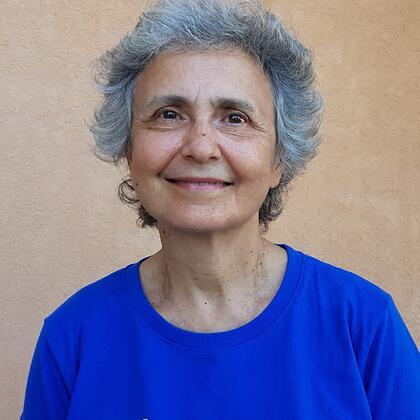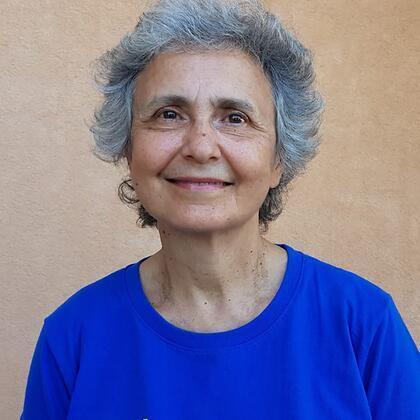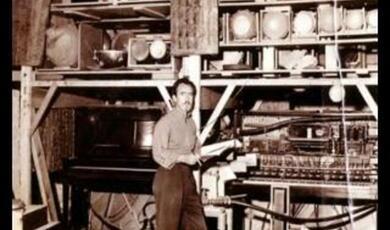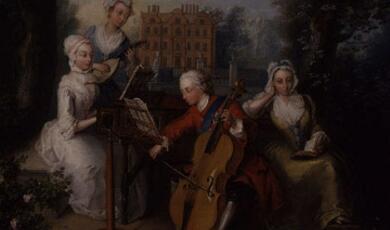Histories of Numbers
Share
- Details
- Text
- Audio
- Downloads
- Extra Reading
This event will focus upon mathematics as expressed in different languages and cultures. The main speaker, Professor Karine Chemla, will discuss Histories of Numbers (6pm).
Download Text
Histories of Numbers
Prof. Karine Chemla
20 October 2021
A Widespread Assumption in the Histories of Numbers
The world history of numeration systems is a subject on which many synthetical books are available today, such as Georges Ifrah’s The Universal History of Numbers and Geneviève Guitel’s Histoire comparée des numérations écrites (Comparative History of Written Numerations), on which the former draws. Beyond the differences between books of this kind, they all share a similar structure. For instance, Georges Ifrah’s monograph is organized as: ‘Numbers of Sumer’, ‘The Development of Written Numerals in Elam and Mesopotamia’, ‘Mesopotamian Numbering after the Eclipse of Sumer’, ‘The Numbers of Ancient Egypt’, ‘Greek and Roman Numerals’, ‘The Numbers of Chinese Civilisation’, and so on. Similarly, the structure of Geneviève Guitel’s Histoire Comparée derives from a classification of the numeration systems she considers.
The leaves of the tree read: “Egypt I (hieroglyphic),” “Aztecs”, “Greece I (attic),” “Rome”, “Sumer,” “Egypt III (hieratic),” “China I (oracle-bones),” and so on. Moreover, horizontal arrows marking the “evolution” of numeration systems are added to the tree, and they also connect “Egypt I” with “Egypt II” and “Egypt III” as well as “Greece II” and “Greece III,” etc. In a way, it seems natural to us that a “History of Numbers” adopts a structure of this kind —that is, to use Guitel’s words, that it gives pride of place to “peoples” and “civilizations.” However, is it so obvious that a structure like this is appropriate? I argue that this feature derives from a tacit assumption that has been widely adopted when it comes to the history of numbers and that needs to be reconsidered.
To explain this point, I will focus on how the history of numbers in China was treated in a monograph that served as a basis for Guitel’s and Ifrah’s chapters on China, namely section “19. Mathematics,” published in Joseph Needham’s (1900-1995) famous encyclopaedic book Science and Civilisation in China, and jointly composed by Needham and Wang Ling (1917-1994).[1] The account of numeral notations given by Needham and Wang draws on a table entitled ‘Ancient and medieval Chinese numeral signs,'.
They begin their account with the earliest forms found, those on “Shang oracle-bones (-14th to -11th centuries)” (column E in the table). Needham and Wang go on to argue that the numerals attested indicate that an evolution took place in China, at the end of which a decimal place-value notation emerged. In other words, just as in the numeration system commonly used today, in which the signs “1,” “2,” “3” in the inscription “123” derive their meaning of, respectively, “one hundred,” “twenty,” and “three” from the positions they occupy in the inscription, according to Needham and Wang, in the system attested in China, numbers were written using positions and the digits featured in column H: the “counting-rod forms.”[2] Needham and Wang’s main claim was thus that this numeration system originated in China, and not in India, as is still commonly assumed today.
I will offer some comments on Needham and Wang’s table, starting from the tacit assumption in which I am interested. In the authors’ view, all the numerals in this table have a first and common basic function: they are used to express numbers. For this function they seem to be interchangeable. It is true that today, we may interchangeably write “one hundred and twenty-three chickens” or “123 chickens.” However, has this always been the case? Note that if we assume that all the numerals that were introduced had in the first place the function of expressing numbers, it is not surprising that the history of numbers be linked to the history of language and writing, and thus that linguistic groups appear as the natural actors in the history of numbers. However, is this assumption valid? I will argue that it is not.
A Problem with the Assumption that Numerals all Express Numbers
To begin with, I claim that the assumption in question has been more generally central in the historiographies of numbers. Take, for instance, Guitel’s book. As we have seen, it is entitled Histoire comparée des numérations écrites (Comparative History of Written Numerations). The title thus makes clear that, for her historical account of numeration systems, Guitel focuses on “written numerations.” She defines them as follows:
“a well-designed written numeration merely translates with conventional signs a spoken numeration that one must assume to be well organized… (Une numération écrite bien conçue ne fait que traduire avec des signes conventionnels une numération parlée que l'on doit supposer bien organisée, …).”[3]
The basic assumption on which her book is predicated is therefore clear: for Guitel, the numeration systems that a history of numbers must take into account are those that correspond to an oral numeration. In other words, these numeration systems are primarily defined by the fact that their basic function is to write down language, and accordingly to express numbers. To put it differently, all the numeration systems considered are similar in nature.
The same assumption can be perceived when historians point out the “ambiguity” of numbers written using a numeration system (see, for example, Ifrah 2000, p 279-280). However, the ancient actors who used the numeration system in question never expressed this concern. This remark implies that actors of the past and historians do not see the numeration system in the same way.
A quick look at Chinese sources will convince us that, when actors of the past employed the numeration system with “counting-rod” numerals (or “rod-numerals”) in their writings, they did not use it interchangeably with the Chinese characters that wrote down the number-words of language. Figure 3 shows a page of a thirteenth-century work by Qin Jiushao 秦九韶, Mathematical Writings in Nine Chapters (Shu shu jiu zhang 數書九章, 1247). The page opposes two types of scriptural spaces. Chinese characters writing down the discursive part of the book occur in narrow columns in which sentences are inscribed one after the other. There, numbers are expressed only using the characters of the Chinese language. In between these columns, the page features larger columns, which illustrate specific inscriptions with which computation was carried out. In these columns, the inscriptions of numbers make use only of rod-numerals, while the rod-numerals do not enter into the inscriptions of sentences. In other words, the book makes use of two different numeration systems, which occur in completely different spaces: they are certainly not interchangeable. In Qin Jiushao’s book, these rod-numerals never occur in the discursive part of the text. When they do, in other documents, they only occur in very specific positions in a sentence, and certainly not to express a quantity.
I have argued elsewhere that inscriptions of this kind were inserted into the pages of writings only from the tenth century. Prior to that, a similar numeration system with rod-numerals did exist. However, rod-numerals were written down only materially, with calculating rods, on a surface on which practitioners carried out computation. This is the decimal place-value numeration system to which Needham and Wang’s column H refers. However, at the time they mention —and notwithstanding their claims—, it did not feature in writings. In contrast with this calculating surface, on which the inscription of numbers was only ephemeral, the mathematical texts that actors read and wrote were purely discursive: numerals in these texts were only characters writing down the number-words of the Chinese language. Put differently, at the time, the divide between two ways of writing down numbers that we have observed in Qin Jiushao’s thirteenth century work (Figure 3), which corresponded to inscriptions fulfilling different functions, was even more conspicuous.
On account of her a priori assumption that a numeration system must be “written” —in her sense of the word— in order to be taken into consideration in a history of numbers, Guitel excludes this material system from the scope of her study. This point can be seen in Figure 2, to the right: her type III of numeration systems presents the place-value numeration systems, and Guitel specifies “written”, adding emphasis to the word. However, given the continuity between the material system and the numeration system featured in later works, and given also the separation that is maintained in Chinese mathematical documents between the inscription of the language and that of rod-numerals, when after the tenth century the latter feature in writings, I would question that rod-numerals might be considered as “written” in Guitel’s sense.
However, the key point is elsewhere. I argue that Arabic mathematical documents attest to a similar evolution. When practitioners writing in Arabic adopted from Sanskrit texts the so-called Arabic numerals using a decimal place-value system, they seem to have used them, to begin with, materially, that is, only written on dust, in the course of computations. If these numerals ever featured in texts at the time, they arguably had the status of illustrations, and were not used to write down the expressions of quantities. Only later, apparently from the tenth century on, do we have evidence that numbers written with these numerals were inserted into Arabic works. What is striking is that just as the case of Chinese mathematical documents, these inscriptions in the pages of Arabic texts had the status of “figures” or else they occurred only in very specific parts in sentences. Even then, they were not used to write down language as we do today. There are reasons to believe that the same conclusion also holds true for Sanskrit texts.
Strikingly, for cuneiform clay tablets from the early second millennium BCE, similar conclusions also apply. The numeration system with which practitioners of mathematics computed was different (it was a sexagesimal place-value numeration system, whose use was quite different from the uses of the present-day decimal place-value systems). Yet, just as we have seen above, quite clearly in second-millennium mathematical tablets, the numeration systems used to record quantities differed from the numeration system used for computation. As shown in Proust (2010), these two systems occurred in completely separated scriptural spaces.
In brief, in many contexts of the ancient world, we thus see actors shaping and using two numeration systems separately: a numeration system used to record quantities and a different one, used for computation but that was employed to express quantities in sentences. These systems were not interchangeable. The impression of similarity in nature between the numeration systems gathered, e.g., in Needham and Wang’s table might be an illusion. This illusion might have been created by the method that produced the table, which consisted in taking the numerical signs out of the contexts in which they were used. Numbers should thus not be considered only in relation to languages. Should they be considered then in relation to cultures? I would argue that this is the case, provided one gives a specific sense to the term “culture.”
The emergence of formalisms in ancient worlds
Do the conclusions reached so far mean that actors expressed quantities with one numeration system and computed with another? This turns out to be true in some contexts, but not in all. Here again, Chinese documents —in this case, scholarly writings from the seventh century—will help us clarify this issue.
A first set of documents was recently uncovered by Yiwen ZHU (Forthcoming). These are seventh-century subcommentaries on ancient commentaries on writings important for Confucian traditions. In the ancient commentaries, exegetes put forward quantitative assertions and they even sometimes outline mathematical procedures. The seventh-century subcommentators, who belonged to milieus connected to the court, set themselves the task of establishing the correctness of these assertions and procedures. To this effect, they develop computations that are extremely interesting to observe. The subcommentators compute with the number-words of the Chinese language. That is to say, they use neither computing tools nor specific numerals. In relation to this, they write down their computations in a discursive manner, and accordingly they never lose sight of the meaning of each of the steps. In fact, these subcommentators compute through reasoning, and they reach the end-result of the computation in a way that makes clear why the result is correct. All the computations in these documents fit this description.
By contrast, in the “School of Mathematics”—an official institution in which mathematics was taught from 656 onwards—, the works used as textbooks described the execution of computations in a wholly different way. These works constitute a second set of documents that I will take into consideration. The work that was the first to be taught in the elementary curriculum—Mathematical Classic by Master Sun (Sun zi suan jing 孫子算經, completed in ca. 400) described how to use calculating rods to represent numbers on a calculating surface, according to a decimal place-value notation essentially identical to that shown in Figure 3. In other words, in contrast with the first set of documents, here specific numerals, distinct from Chinese characters writing number-words, were used to carry out computations. Mathematical Classic by Master Sun further explains how to execute multiplication and division using this type of representation of numbers.
The execution of multiplication and division is carried out, relying on the initial inscription of numbers and, then, the successive states of the inscriptions on the calculating surface throughout the computation. The practitioner who employed this way of computing did not follow the meaning of the operations while computing. He or she applied rules in relation to the form of the inscription. In contrast with the computations described in the first set of documents, those attested to in the mathematical works used as textbooks were formal. Despite the fact that these two sets of Chinese documents were used more or less at the same time and in the same place, I would refer to them as attesting to two different cultures of computation. It is with respect to cultures of this kind —and not for China as a whole—that we can observe the various types of numerals conjointly used and how they were employed.
On the decimal place-value numeration system that was introduced in Arabic translations of Sanskrit texts and later in Latin translations of Arabic texts, Charles Burnett has this to say:
“Mathematical notation is independent of language; it is symbolic, and does not represent sounds. Therefore, there is no need for different notations to be used in different languages, even when they are written in different scripts. Nowadays, the same mathematical notation is used and understood throughout the world, by Chinese, Arabic, Russian and American mathematicians. There was a potential for this to happen in the Middle Ages too. The Indians had invented a symbolic notation for the nine digits and the zero, which was taken over by Syrian and Arabic writers and eventually passed to Western Europeans. Scholars writing in Syriac, Arabic, and Latin alike referred to these symbols as "Indian figures,” and they all participated in the same, distinctive, method of calculating with them. Thus a common mathematical language was shared by mathematicians in Bath and Baghdad, in Roskilde and Marrakesh.”[4]
Burnett underlines that in contrast with mathematical formulas used today, which are written more or less uniformly throughout the world, the numerical signs with which numbers were written using a decimal place-value notation in the Middle Ages varied. However, he goes on, notwithstanding this variation in signs, this constituted a common mathematical language. I wholly agree with his conclusion, simply adding that this shared language was also used in some mathematical cultures in China.
I would also add that the earliest Chinese, Sanskrit, and Arabic sources attesting to this numeration system also have in common the fact that they refer to this system as written materially on an erasable surface. If this is the case, this means that the circulation of the system took place even before illustrations for it were inserted into the pages of writing. What is more, it seems that, in all the regions in which numerations systems of this type are attested, the layouts for computation were similar, and also that we can identify the same process of transfer of these notations onto paper (or palm-leaves in South Asia), to begin with as illustrations. This suggests that the mathematical cultures of those using systems of this kind remained in interaction with each other, across linguistic borders. Even though some mathematical cultures, like the one exemplified by the first set of Chinese documents mentioned above, might have remained confined to Chinese-writing contexts, others —like the one attested to by the second set of Chinese documents— appear to have been part of a wider mathematical world that went across linguistic borders. From this perspective, although the usual structure of histories of numbers in the form of chapters bearing on “linguistic groups” might be relevant for some mathematical cultures, it is not for others. In fact, I would argue that a structure of this kind hides the diversity of cultures that can be identified within China, and also within South Asia and within the Arabic world. More importantly, it hides essential phenomena of the type Burnett explores in the quote above.
Burnett also emphasizes that notations of this kind, like the symbolic notations of present-day mathematics, were independent of language: we have seen the deep reasons for which this conclusion holds true even more widely than indicated by Burnett. This does not mean that verbalizations were not attached to notations. However, these notations were not writing down linguistic utterances, and they circulated independently of any verbalization.
Burnett compares the decimal place-value inscriptions to modern mathematical symbolism because of the way all of these notations circulated. We have seen that there was one more reason to carry out this comparison: whether we consider the computations carried out in early imperial China with rod-numerals or in modern times with formulas, they are all executed in a formal way, depending on the form of the inscriptions and not on their content.
The history of mathematical symbolism has commonly put forward the idea that symbolism began in sixteenth-century Europe. This view has been challenged, on the basis of the fact that earlier Arabic texts from Maghreb or even Latin texts contained notations that could be considered symbolic. In my view, Burnett is right to suggest that the notations of numbers with a decimal place-value system already fall within the purview of symbolic notations. To the reasons he put forward, I have added the formal character of the computations that relied on inscriptions of this kind. These remarks are a strong incentive for us to reopen the history of mathematical symbolism from a new and broader perspective.
© Professor Karine Chemla 2021
References and Further Reading
Burnett, Charles. "Indian Numerals in the Mediterranean Basin in the Twelfth Century, with Special Reference to the 'Eastern Forms'." In From China to Paris: 2000 Years’ Transmission of Mathematical Ideas, edited by Y. Dold-Samplonius, J. W. Dauben, M. Folkerts and B. van Dalen, Stuttgart: Steiner, 2002, pp 237-288. Reprinted in Charles Burnett, Numerals and Arithmetic in the Middle Ages. Farnham & Burlington: Ashgate Variorum, 2010, pp 237-288.
Chemla, Karine, Agathe Keller, and Christine Proust, eds. Cultures of computation and quantification in the ancient world. Numbers, measurements, and operations in documents from Mesopotamia, China and South Asia, Why the Sciences of the Ancient World Matter. Cham: Springer Nature, Forthcoming.
Guitel, Geneviève. "Classification hiérarchisée des numérations écrites." Annales. Économies, Sociétés, Civilisations 21, no. 5 (1966), pp 959-981. https://www.persee.fr/doc/ahess_0395-2649_1966_num_21_5_421444
Guitel, Geneviève. Histoire comparée des numérations écrites. Paris: Flammarion, 1975.
Ifrah, Georges. The Universal History of Numbers. From Prehistory to the Invention of the Computer. Translated by E. F. Harding Translated from the French by David Bellos, Sophie Wood, and Ian Monk. New York: John Wiley and Sons, 2000.
Needham, Joseph, and Wang Ling. "section 19: Mathematics." In Science and civilisation in China, edited by Joseph Needham, Volume III. Cambridge (UK): Cambridge University Press, 1959, pp 1-168.
Proust, Christine. "Mesopotamian Metrological Lists And Tables: Forgotten Sources." In Looking at it from Asia: the processes that shaped the sources of history of science, edited by Florence Bretelle-Establet. Dordrecht: Springer, 2010, pp 245-276.
Zhu Yiwen 朱一文. "Different cultures of computation in seventh century China from the viewpoint of square root extraction." Historia Mathematica 43, 2016, pp 3–25.
Zhu Yiwen 朱一文. "Another Culture of Computation from 7th century China." In Cultures of computation and quantification in the ancient world. Numbers, measurements, and operations in documents from Mesopotamia, China and South Asia, edited by Karine Chemla, Agathe Keller and Christine Proust. Dordrecht: Springer, Forthcoming.
[1] See the subsection “Numeral notation, place-value and zero,” in Needham, Joseph, and Wang Ling. “Section 19: Mathematics.” In Science and civilisation in China, edited by Joseph Needham, Volume III. Cambridge (UK): Cambridge University Press, 1959, pp 5-17.
[2] Note that in their reading of column H, Needham and Wang interpret the numerical signs they give for numbers as representing digits in a place-value system.
[3] Guitel 1966, p 959. My emphasis.
[4] Burnett, Charles. “Indian Numerals in the Mediterranean Basin in the Twelfth Century, with Special Reference to the 'Eastern Forms’.” 2002. In Charles Burnett, Numerals and Arithmetic in the Middle Ages, 2010, p 237. My emphasis.
References and Further Reading
Burnett, Charles. "Indian Numerals in the Mediterranean Basin in the Twelfth Century, with Special Reference to the 'Eastern Forms'." In From China to Paris: 2000 Years’ Transmission of Mathematical Ideas, edited by Y. Dold-Samplonius, J. W. Dauben, M. Folkerts and B. van Dalen, Stuttgart: Steiner, 2002, pp 237-288. Reprinted in Charles Burnett, Numerals and Arithmetic in the Middle Ages. Farnham & Burlington: Ashgate Variorum, 2010, pp 237-288.
Chemla, Karine, Agathe Keller, and Christine Proust, eds. Cultures of computation and quantification in the ancient world. Numbers, measurements, and operations in documents from Mesopotamia, China and South Asia, Why the Sciences of the Ancient World Matter. Cham: Springer Nature, Forthcoming.
Guitel, Geneviève. "Classification hiérarchisée des numérations écrites." Annales. Économies, Sociétés, Civilisations 21, no. 5 (1966), pp 959-981. https://www.persee.fr/doc/ahess_0395-2649_1966_num_21_5_421444
Guitel, Geneviève. Histoire comparée des numérations écrites. Paris: Flammarion, 1975.
Ifrah, Georges. The Universal History of Numbers. From Prehistory to the Invention of the Computer. Translated by E. F. Harding Translated from the French by David Bellos, Sophie Wood, and Ian Monk. New York: John Wiley and Sons, 2000.
Needham, Joseph, and Wang Ling. "section 19: Mathematics." In Science and civilisation in China, edited by Joseph Needham, Volume III. Cambridge (UK): Cambridge University Press, 1959, pp 1-168.
Proust, Christine. "Mesopotamian Metrological Lists And Tables: Forgotten Sources." In Looking at it from Asia: the processes that shaped the sources of history of science, edited by Florence Bretelle-Establet. Dordrecht: Springer, 2010, pp 245-276.
Zhu Yiwen 朱一文. "Different cultures of computation in seventh century China from the viewpoint of square root extraction." Historia Mathematica 43, 2016, pp 3–25.
Zhu Yiwen 朱一文. "Another Culture of Computation from 7th century China." In Cultures of computation and quantification in the ancient world. Numbers, measurements, and operations in documents from Mesopotamia, China and South Asia, edited by Karine Chemla, Agathe Keller and Christine Proust. Dordrecht: Springer, Forthcoming.
This event was on Wed, 20 Oct 2021
Support Gresham
Gresham College has offered an outstanding education to the public free of charge for over 400 years. Today, Gresham College plays an important role in fostering a love of learning and a greater understanding of ourselves and the world around us. Your donation will help to widen our reach and to broaden our audience, allowing more people to benefit from a high-quality education from some of the brightest minds.


 Login
Login







